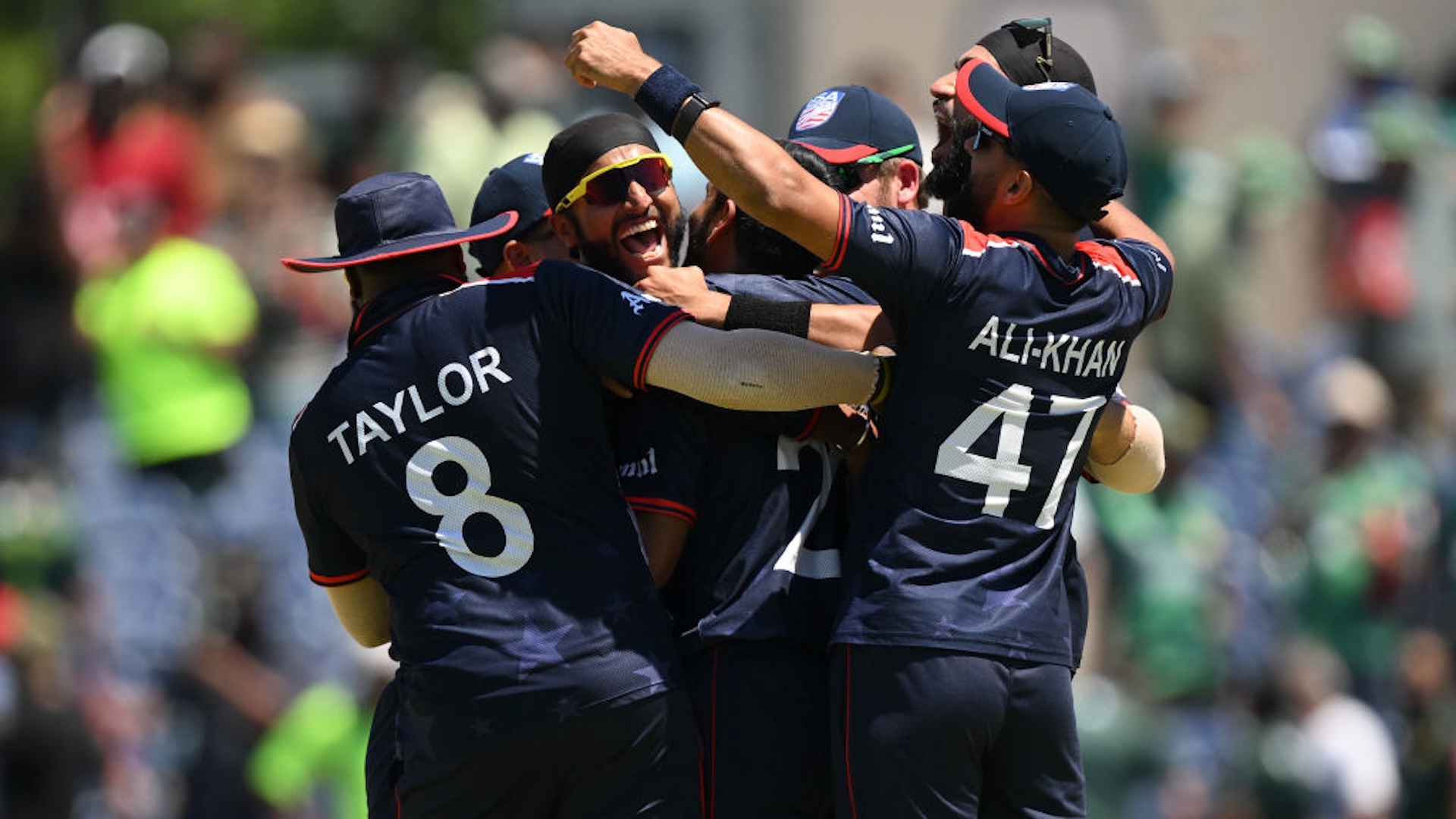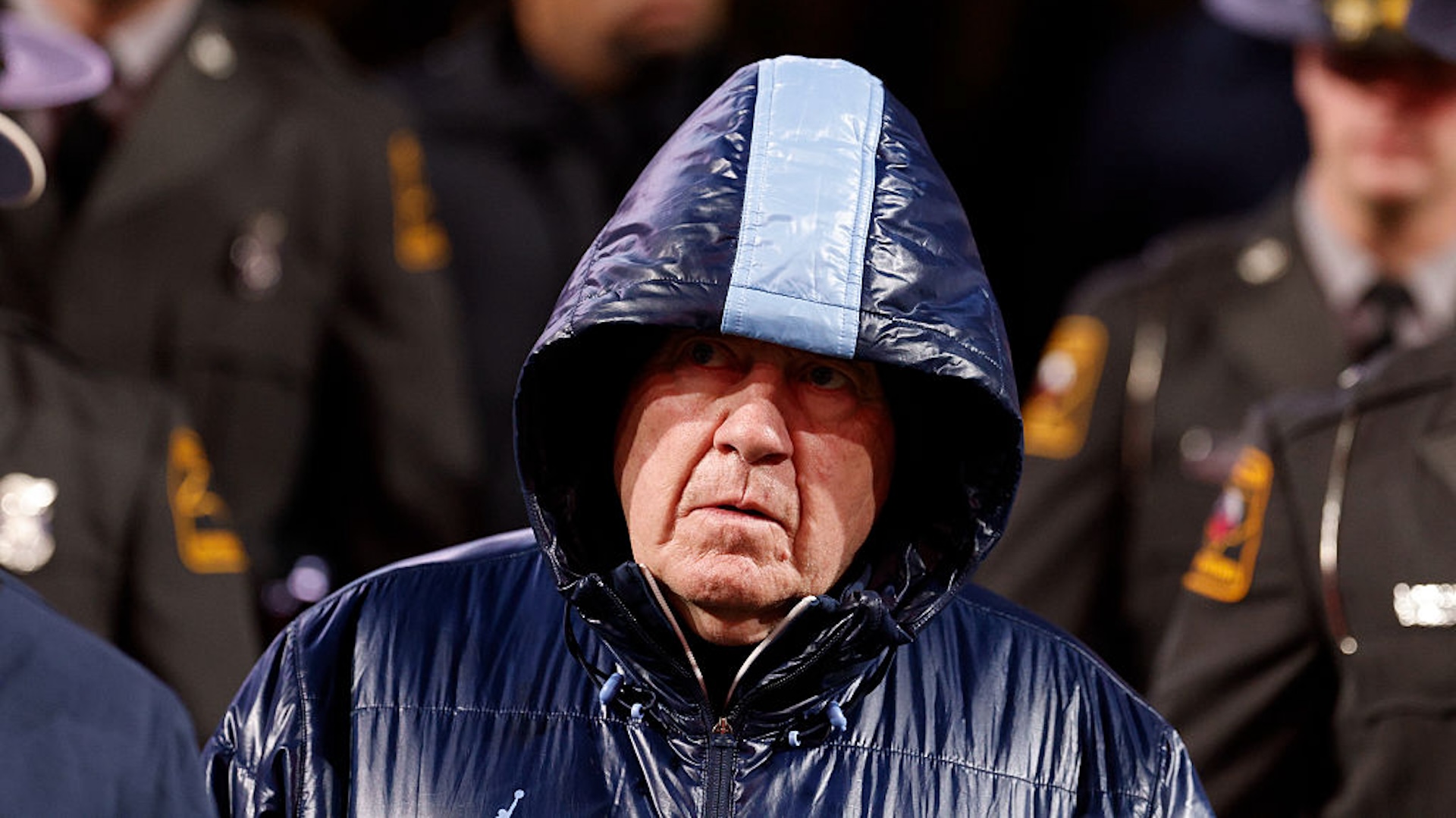You’re forgiven if, before reading this headline—or maybe getting an alert on your phone a few days back—you didn’t even know that the United States had a cricket team.
And yet scores of Americans spent a good chunk of last week obsessively checking the weather forecast and rooting for rain, all because of what it would mean for the U.S. cricket team. The reason: The Americans were a result away from advancing to the next round of the T20 World Cup, and in many competitions a rainout counts as a draw for both teams. No matter how one-sided a contest might figure to be—say the first 11 commenters on this post were somehow paired against an India team led by in-their-primes Sachin Tendulkar, Sourav Ganguly, MS Dhoni, and Virat Kohli—enough precipitation could make them split the points as if they were equals.
By last Friday, when the U.S. was scheduled to play Ireland in Florida, the Americans already had enough points that a rainout, and subsequent draw, meant they were moving on in a tournament where only eight of 20 teams get to claim that distinction, and in a sport where power is typically concentrated among a very small number of nations.
It wasn’t bad weather that had gotten the U.S. to this point. It was their play in the three matches prior, which was so out-of-nowhere impressive—at least to those who hadn't been paying very close attention to the Americans—that it brought about what so far is the question of this tournament: Is the U.S. actually kind of good at cricket now?
Globally, cricket’s popularity runs deep, but not wide. The world’s largest country by population (India) and two more of the top eight (Pakistan and Bangladesh) count cricket as their favorite sport. But only a few other nations treat this bat-and-ball game like a legitimate pastime, nearly all of them members or former members of the British Commonwealth. The ICC (International Cricket Council) recognizes only 12 governing bodies—some sovereign nations, some conglomerations of countries—globally as “full” members; all others are “associate” members. This means that, while it’s not stated as such, those full members are effectively considered the only ones worth taking seriously. For comparison, imagine if FIFA deemed only the top 12 footballing nations full members, or if the 12 biggest European soccer clubs decided to break off and form some kind of a “super” lea—wait, never mind, we’re getting off course.
The point is, despite having a global fan base in the billions, giant swaths of the planet can’t tell an over from a wicket, and probably think a bowler is someone who shouts “Who do you think you are? I am!”
That, of course, includes the U.S.
Here, cricket did have something of a presence in previous centuries; this country, too, used to be claimed by the Brits. But due to our staunch commitment to making up and promoting our own games, baseball eventually beat it out, turning cricket—even in Philadelphia—into an effective non-entity by the early 20th century.
USA cricket persisted in tiny pockets, usually only among people who had moved here from one of those full member nations or whose relatives had done so. When the ICC in 1965 created that new “associate member” label, the U.S. was one of the first two nations granted it, and over time the country saw itself placed alongside a host of secondary nations who played the game in some capacity but weren’t deemed worthy of the big time.
From 1965 on, cricket not only never took off in the States, its standing got even less secure. In a 2011 tournament, the team was being represented by, as longtime USA cricket writer Peter Della Penna put it, “whoever answered their phones.” By 2017, the 52-year-old USA Cricket Association was being unanimously expelled by the ICC for years of mismanagement and running up debt. USA cricket stayed alive, and a new governing body—called, appropriately, USA Cricket—was admitted back into the ICC in 2019, bringing with it hope and some decent results. But in early 2020, this was still a team that was capable of being bowled out for 35 by Nepal (this score would be bad against anybody, but is almost unfathomable against a non-power).
Fast-forward to June 6, 2024, in suburban Dallas. The U.S. had already beaten rival Canada in the opening match of the T20 World Cup, chasing down an impressive 194 total with 14 balls remaining (this means the win didn’t go down to the wire). But a game against Pakistan, which at the time was ranked no worse than sixth in any of cricket’s three formats, seemed little more than a chance to gain valuable experience; did we mention yet that this is the U.S.’ first ever appearance in this tournament?
Consider, too, some of the other results between full and associate member nations in this tournament: Afghanistan beat Uganda by 125 runs (that’s a lot). India chased down Ireland in just 12.2 overs (that’s not a lot). Australia eased past Oman and clobbered Namibia (both entered the tournament ranked ahead of or near the U.S.).
The match started, and Pakistan put up a solid run total (in short cricket matches like these, teams do all their batting at once); ESPN Cricinfo’s commentator called it, in the moment, “a good score,” but still acknowledged the possibility of an upset.
An upset is exactly what we got, thanks to a complete batting and bowling performance from the Americans that seemed anything but flukey. It required a Super Over (think extra innings or overtime, only rarer) thanks to a clutch last-ball boundary (think, um, a game-tying double? Only better?) by the USA’s Nitish Kumar that leveled the scores after 240 balls were bowled. That Super Over saw solid batting from Aaron Jones and was finished off by strong bowling from Saurabh Netravalkar. Sure, Pakistan falling in big moments is not unheard of, but in a sport where, unlike soccer, the “smash-and-grab” underdog victory rarely takes place, this result was really, truly something.
Then, remarkably, the U.S. followed it up with a performance that, from some angles, might look even more impressive: They played No. 1-ranked India tough—so tough that, before an unprecedented and crippling late penalty for slow play (think pitch clock violation), there was actually a nonzero chance that the U.S. could win.
“Playing here wasn’t easy, could’ve been anyone’s game,” India captain Rohit Sharma said right after the match. “[The U.S. are] hard-working guys making a mark.”
“It was a very spirited performance,” India cricketer-turned-commentator Varun Aaron said on ESPN Cricinfo’s post-match livestream. “They are one of those teams which are in ascendance.”
Nobody on Team USA spent their glory days as an Indiana high school leg spinner. No one was a standout wicketkeeper at Montverde Academy. Instead, this ascendance—which also includes a history-making series win vs. full member Bangladesh just before the start of the T20 World Cup—has come via a cleverly built squad featuring players from all over the cricketing world.
Only four from the 15-man T20 World Cup roster were born in the U.S., and three of them left the U.S. for more cricket-obsessed countries at a young age. Multiple players were born and raised overseas and moved here for work; following the USA’s win over Pakistan, India Express labeled the squad “Team H-1B.”
Netravalkar—the team’s breakout star who bowled that key Super Over vs. Pakistan and, against India, took the wicket of the legendary Virat Kohli (he of 269 million Instagram followers)—famously works as a software engineer at Oracle; his LinkedIn profile went viral after the Pakistan win. Ali Khan, who in 2020 became the first USA cricketer ever to play in the Indian Premier League (cricket’s equivalent of the English Premier League), moved to the U.S. after growing up in Pakistan and, appropriately, worked for Cricket Wireless in Dayton, Ohio.
Netravalkar, who was a talented cricketer growing up in Mumbai but just didn’t have the stuff to make it at the highest level, didn’t come to the U.S. for an easier path to the international game. When he moved, it was for a master’s degree, and he thought he was leaving the game behind.
“I never dreamt that I'd get to play cricket again,” he said in a 2023 interview. “I didn't even bring my cricket shoes."
But a recent shift in ICC residency rules allowed players like Netravalkar to pick up a ball once more. Those rules, plus the recently launched Major League Cricket, have empowered USA Cricket to recruit overseas cricketers such as New Zealander Corey Anderson and Mumbai-born Harmeet Singh; one must only live in a country for three years before being able to play for their national team.
The group is also led by experienced coach Stuart Law, a former Australia international who had overseen Bangladesh, West Indies, and various aspects of his home nation’s cricket team before coming stateside.
In other words, the U.S. is not experiencing a “Golden Generation” moment. Instead, as long as the money and opportunities are there, the approach seems sustainable.
So what does this mean for the future of the sport in the States?
First, it’s inarguable that there is a thirst for the sport in significant pockets around the country.
Tickets to the India vs. Pakistan T20 World Cup match, played at a makeshift stadium on Long Island that did not exactly draw rave reviews, were fetching hundreds of dollars at minimum on game day. A 2023 report stated that Willow TV—a paid streaming service that shows most live cricket in the U.S.—has more than 250,000 subscribers between the Dallas and Houston areas alone. When the U.S. played India in their T20 World Cup match, enthusiasm for the game reigned over animosity, as most fans reportedly were cheering for both teams throughout the day.
“You can find cricket just about anywhere, you just have to look really hard to find it—it’s almost a secret society,” Della Penna told Slate’s Hang Up and Listen podcast.
It is, like most niche sports in the U.S., largely culturally centered; the three stateside T20 World Cup venues were placed in areas (Dallas, New York, South Florida) with significant populations from or connected to places where cricket is huge. It’s to be seen if the sport can break significantly beyond those groups.
Willow TV might be an obstacle, too; though cricket matches occasionally pop up on ESPN+, putting nearly all live cricket—including these T20 World Cup matches—behind a paywall might work to enrich fandom among those already interested, but certainly excludes those necessary-for-growth casuals. (To be fair, YES Network has agreed to broadcast a few Major League Cricket matches this coming season.)
The aforementioned, Queens-born, Barbados-raised USA cricketer Aaron Jones—whose 94 not out against Canada was one of the performances of the tournament—wants better promotion for cricket in the country, but believes it could grow steadily if it ever got into the school system.
All of this is to say that it’s unlikely cricket sees a boom in the U.S. the way soccer did after the 1994 World Cup. But it isn’t going away.
The same could be said for the U.S. team. There is an ocean’s distance between where they are now and where powers like Pakistan reside. America’s success this year has come in the truncated T20 version of cricket; they’re still seeking significant achievements in the longer ODI format, and they’re not even eligible to play the sport’s (somewhat infamous, if you’re not a fan) five-day test matches.
But in the T20 World Cup, the U.S. is certainly not done. Despite their players’ wishes—cricketers want to play, after all—the U.S. got the washout they needed to clinch qualification for the Super Eights round. This has automatically earned them a bid to the 2026 T20 World Cup; for 2024, matches with South Africa (Wednesday), West Indies (Friday), and England (Sunday) are next.
At this point, fans likely won’t be hoping for more bad weather. Given what the U.S. has accomplished already, observers will want to see what else they can do—especially the ones who just learned the team existed.







